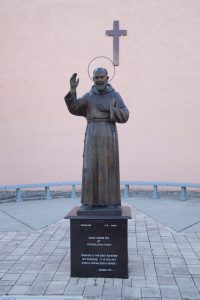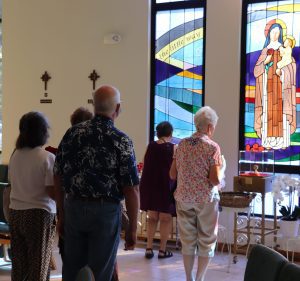From the earliest years of the Church relics from the bodies of the saints and martyrs have been vivid reminders to the faithful of the heroic virtue that God worked in and through their lives.
Catholics venerate relics of saints as a means of asking their intercession before the Lord. It is well documented in Christian history that credible blessings, favors, miracles and conversions have taken place due to the intercession of saints.

For this reason, hundreds gathered for a visitation of a relic of St. Padre Pio on Sept. 28, 2024, at Our Lady Queen of Martyrs Parish in Sarasota. The relic, a cloth stained with the blood of the saint who was known for many extraordinary gifts, including stigmata, prophecy, ability to speak languages he had never studied, gift of conversions and more.
Father John Hoang, Pastor of Our Lady Queen of Martyrs, said the Parish was blessed to have the relic available for public display. The visitation closely coincided with the 25th anniversary of his beatification (1999), Sept. 23. St. Padre Pio passed away in 1968 and was beatified in 1999, and was canonized by St. John Paul II in 2002.
Father Hoang encouraged the faithful to venerate the relic, and spend a few moments in quiet devotion. “You can devoutly ask the Lord for His intercession for any intention you carry in your heart.”
The day began with the offering of the Sacrament of Reconciliation prior to the Sunday Vigil Mass. The relic was placed on a table ahead of the front pew during the Mass.

After Mass, the faithful were encouraged to come forward. Many touched the reliquary (the metal container holding the relic) with rosaries, prayer cards, and other objects, as a means of intercessory prayer. Still others kissed the reliquary.
Christina Reynolds of St. Joseph Parish in Bradenton was a visitor to Our Lady Queen of Martyrs specifically to be near the relic of St. Padre Pio, bringing two rosaries and three prayer cards to touch the reliquary.
“He was a remarkable man who was given great gifts,” Reynolds said. “To know that his blood is present in the reliquary means so much to me. I feel honored to be in its presence.”
Holding the reliquary was Gino D’Alessandro, who leads the Parish devotional to St. Padre Pio. During a reception in the Parish hall, D’Alessandro offered stories about how he began his own personal devotion to the saint. His devotion included the backing of the construction of a Shrine to St. Padre Pio next to the Parish Hall. The Shrine was dedicated by Bishop Frank J. Dewane in 2008. A movie documenting the saint’s extraordinary life was also presented.
Born to a peasant farmer in Pietrelcina, Italy, in 1887, St. Padre Pio decided at a very young age to dedicate his life to God. First experiencing the stigmata in 1916, he shied away from public ministry until 1934. In 1947, Father Karol Wojtyla visited Padre Pio who prophetically told him he would rise to the highest post in the Church. Father Wojtyla later became Pope John Paul II. St. Padre Pio became internationally famous. He was known for his piety, charity and the quality of his preaching. He famously advised, “Pray, hope and don’t worry.” He is the patron of civil defense volunteers, adolescents, and the village of Pietrelcina.
Relics
Relics are usually broken down into three classes. First class relics are the body or fragments of the body of a saint.
Second class relics are something that personally belonged to a saint such as a shirt, prayer card, sacred vessel or vestment, or book (or fragments of those items). Third class relics are items that a saint touched or that have been touched to a first- or second-class relic of a saint. Sacred Scripture teaches that God can act through relics, especially in terms of healing and intercession.
Most Catholic church altars are embedded with relics. Many Parish churches host additional relics for veneration.
Reverencing the saints through the use of relics is not a required devotion of the Catholic Church but does reflect the Church’s belief that the saints in Heaven continue to intercede for us in response to our prayers. However, veneration of the saints through their relics — along with praying the rosary, wearing medals and going on pilgrimages — should not be misconstrued as adoration or worship, which are due to God alone according to the Church.









 Father Jan Antonik, Parish Administrator, told a large gathering how honored and blessed the Parish was to have a First-Class Relic of St. Thérèse, something he strived to acquire since his appointment in early 2020. The relic was gifted to the Parish courtesy of Father Bob Kantor, Pastor of St. Agnes Parish in Naples, where it had been on display in the St. Agnes Adoration Chapel for many years. Bishop Frank J. Dewane approved and facilitated the transfer of the relic between the two Parishes
Father Jan Antonik, Parish Administrator, told a large gathering how honored and blessed the Parish was to have a First-Class Relic of St. Thérèse, something he strived to acquire since his appointment in early 2020. The relic was gifted to the Parish courtesy of Father Bob Kantor, Pastor of St. Agnes Parish in Naples, where it had been on display in the St. Agnes Adoration Chapel for many years. Bishop Frank J. Dewane approved and facilitated the transfer of the relic between the two Parishes St. Thérèse was a Carmelite nun who was born in 1873. She entered a cloistered life at the age of 15, living in near obscurity at a convent in Lisieux, France and died at the age of 24. She was canonized in 1925 and in 1997 St. John Paul II proclaimed her a Doctor of the Church in light of holiness and the influence of her teaching on spirituality in the Church.
St. Thérèse was a Carmelite nun who was born in 1873. She entered a cloistered life at the age of 15, living in near obscurity at a convent in Lisieux, France and died at the age of 24. She was canonized in 1925 and in 1997 St. John Paul II proclaimed her a Doctor of the Church in light of holiness and the influence of her teaching on spirituality in the Church. Following Mass, single roses were distributed for the faithful to give to others as a “little way” of spreading the Love of Christ to others. Many also paused to view the relic and/or light a candle. A reception was held as part of the Feast Day celebration.
Following Mass, single roses were distributed for the faithful to give to others as a “little way” of spreading the Love of Christ to others. Many also paused to view the relic and/or light a candle. A reception was held as part of the Feast Day celebration.